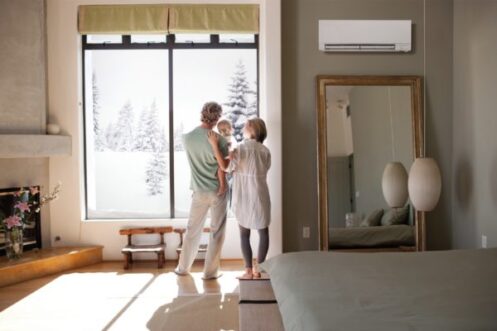
Ductless mini splits are a unique type of HVAC unit that can both heat and cool. These units are designed for use in buildings with no central heating or air conditioning system, as they operate without the need for ductwork. They are also a great option for additions that aren’t connected to the central HVAC system or for any rooms or areas where you may need to supplement your heating and cooling.
As with any other type of HVAC unit, it is vital that you choose a ductless mini split that is the right size for the space. If not, the unit may not heat or cool sufficiently. An oversized or undersized unit will also lead to higher energy bills, experience more frequent issues and likely break down much sooner. With all this in mind, here is a quick overview of how to calculate what size of ductless mini split you need.
Determining Your Needs
Most mini splits are designed to heat or cool just one room or space, but there are systems that can control the temperature throughout an entire home. These systems still have one outdoor heat pump that is connected to multiple indoor air handlers. In order to heat and cool the entire home, you will generally need to have an air handler in every room or space. This is important to consider, as the more space there is and the more air handlers you have, the larger the mini-split heat pump will need to be.
You will also want to carefully consider your specific needs and how you plan on using your mini split. Are you mainly looking to use it to keep your home cool during the summer, or will you also use it for heating during the winter? If you plan on using your mini split for heating as well, you will typically need a slightly larger unit. This is especially true in colder northern climates like Washington since the BTU (British Thermal Units) requirements per square foot are slightly higher for heating than for cooling.
Calculating Square Footage
The first thing you’ll need to do to calculate what size of mini split you need is to determine the square footage of the space. If you’re only using the mini split to heat and cool one area, all you need to do is measure the length and width of the room and then multiply these together to get the square footage. If you plan on having multiple air handlers in different rooms, you will need to calculate the square footage of each room and then add them together. If you’re using it to heat and cool an entire building, you will need to calculate the square footage of the entire habitable space, including hallways.
Using Square Footage to Estimate BTU Requirements
Once you know the total square footage, you can then use this to estimate how many BTUs of cooling and/or heating you need. If you only plan on using the mini split for air conditioning, you will need approximately 20 BTUs for every square foot. If you also plan on using your mini split for heating, you will need a unit that produces more BTUs than you would if you only used it for cooling. In this case, we recommend that you have at least 25 to 35 BTUs per square foot.
Other Factors to Consider
Calculating how many BTUs you need based on square footage will give you a rough estimate of what size of mini split you need. However, there are also other factors that need to be taken into account to ensure that the mini split is the right size. The most important of these is how well-insulated the area is and the number, size and location of any windows and doors in the space.
If the space isn’t well insulated, it will allow lots of hot air in during the summer and also let heat escape in the winter. As a result, you will need a much larger mini split in a poorly insulated space than you would in one that is well insulated and sealed up tightly to help overcome heat loss and heat gain.
Windows and doors are also major sources of both heat loss and heat gain. If you have lots of large windows, especially ones that face south or west, then you will need a larger mini split to cool the area due to the huge amount of heat coming from your sun-lit windows. The same is also true if you have old single-pane windows or your windows and doors are drafty since these issues will also allow lots of hot air inside.
The best way to determine what size of mini split you need is to have a certified HVAC technician do all the calculations for you, which we do. We specialize in mini-split installation, repair and maintenance needs, and we also service and install furnaces, air conditioners, heat pumps, ductwork and indoor air quality equipment. To learn more about your mini-split options or if you need any HVAC service in the Oak Harbor area, give Island Heating & Air Conditioning a call today.
Tags: Ductless Mini-Split, Mini-Split Installation, Mini-Split System, Mini-Split TipsTags: Energy Efficiency, HVAC
December 19, 2022 8:10 pm

